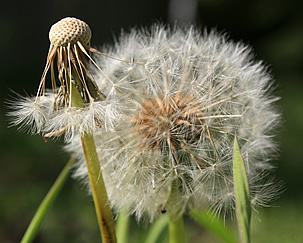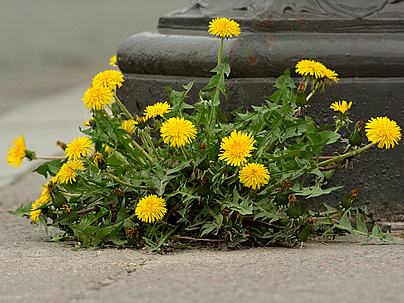The dandelion (Taraxacum officinale) is a herbaceous perennial plant native to the European continent, commonly known as a weed with a cosmopolitan distribution. It features a long taproot and basal leaves arranged in a rosette, oblong to oblanceolate, glabrous or pubescent, and irregularly lobed, with a bitter milky sap.
Its composite inflorescences are of the capitulum type and emerge on erect scapes at any time of the year. They display yellow ligulate corolla flowers that, through apomixis (asexual reproduction), give rise to fusiform achenes, brown in color, equipped with white silky bristles, allowing the fruit to travel great distances when carried by the wind. The aggregate of fruits has a spherical, fluffy shape, resembling a “pompom.”

The dandelion is considered a significant weed, especially in lawns, where it proves difficult to eradicate due to its easily breaking taproot, persisting in the soil and regrowing after attempted removal. Nevertheless, it is also edible, frequently listed among neglected and underutilized species known as “NUS.”
Dandelion leaves are an interesting source of vitamins A, B, and C, as well as rich in iron and potassium. They can be consumed raw in salads and green juices or cooked and sautéed, much like spinach. Mature leaves are often very bitter and are preferred for sautéing, while young leaves are ideal for raw preparations.
From its roots, toasted and ground into powder, it is possible to make a coffee substitute beverage, similar to chicory. With the flowers, one can make jelly, syrup, and wine. Despite all its qualities as a vegetable, the dandelion still holds a high reputation as a medicinal plant, treating and preventing a multitude of diseases (see table below).
It should be cultivated in full sun or partial shade, in any type of soil but preferably fertile and regularly irrigated. Dandelions grow spontaneously in vacant lots and along roadsides but seem to have a special preference for well-maintained lawns. To control them in these situations, a weeder or knife should be used, loosening the soil around the plant’s root to allow for complete removal. Another way to control this species is by using a flame weeder, especially useful on pavements with pavers or stones.
Selective herbicides are also efficient in large areas where manual control becomes impractical but should be used under careful guidance and supervision of an agronomist. Dandelions easily multiply by seeds. When cultivating it as a vegetable, it is common to treat it as an annual to prevent fructification, as it can quickly spread and infest nearby gardens.

